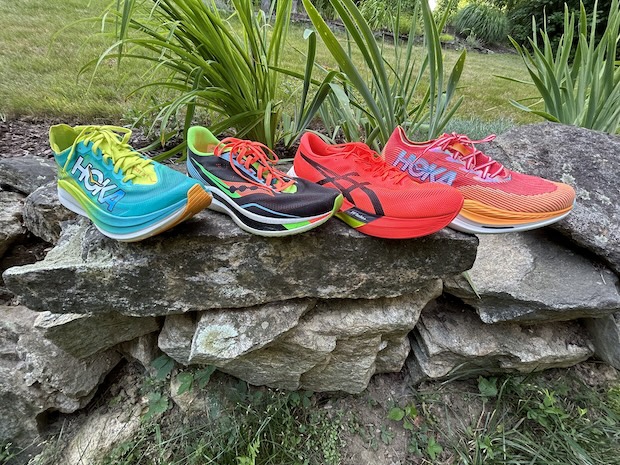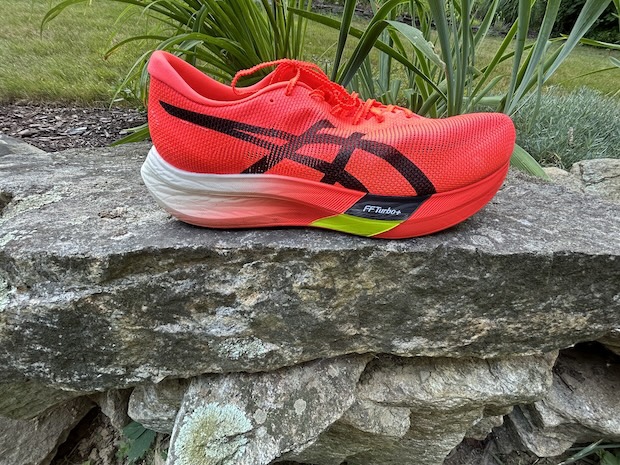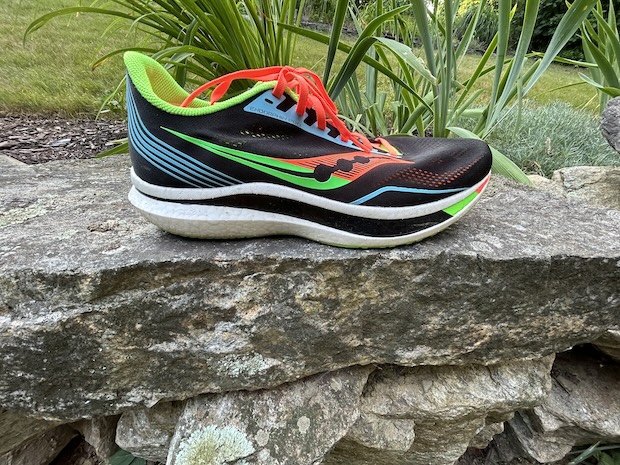Gear Battle: Run Shoes for IM Lake Placid

As a self-admitted gear nerd, particularly for running shoes, this article’s been germinating in my head ever since I decided to enter IRONMAN Lake Placid. The mission: take four pairs of shoes that I was contemplating wearing for the race, put them through a series of tests, and come away with a winner. Sounds simple, right?
The hard part was coming up with the comparison set. Some of that is wallet-related — two of the four shoes in this test were paid for out of my own pocket. But it was also trying to figure out a fair set of shoes to compare against. I respond extremely well to carbon-plated shoes, but seeing as I’m not exactly expecting a blazing run time in LP, would that be the right play?
Ultimately I settled on four options, all of them with carbon-plates, with an added criteria for slow-speed comfort. Because, well, let’s face it — the wheels are likely to come off at some point, and I’d like to be prepared for that moment.
Let’s meet the contenders. We have two entrants from HOKA — the still available Rocket X2 that put HOKA’s racing line-up on the map, and the new this year Cielo X1. Both shoes tower over the competition in physical height, although all meet the World Athletics criteria for measured stack. I purchased a pair of Asics MetaSpeed Sky Paris, as I was first shocked that Fleet Feet West Hartford even had a pair of fun shoes in my size in stock (nobody carries a 13 in anything fun) and then wowed by the try-on feel. And, lastly, I had to put old reliable in the mix: a pair of Saucony’s Endorphin Pro, but two generations old. Why not the newer ones? Because I tend to prefer lower drop shoes, and because the mid foot carve out has gotten so narrow as to be untenable for my foot shape and gait.
Before we dive in, a quick discarding of why some shoes aren’t here. Nike’s carbon shoes are so narrow under the mid foot that it aggravates some posterior tibial tendonitis symptoms. I found On to be far too harsh of a ride with a poor fit. I could not find a local shop that carried Brooks Hyperion Elite without forcing me to pay up front for it as a special order. And New Balance was out of stock of the FuelCell SuperComp Elite v4.
Let’s start comparing.
Uppers and Initial Feel
When I was working shoe floors, we used to say that the first feeling once you put on a shoe would make or break the experience. If you don’t like a shoe the second you put it on, it is highly unlikely that shoe feel is going to get much better when you start running in it. There are some exceptions to that rule — one of them in this comparison — but it’s a good rule of thumb.

Despite both being from HOKA, the Cielo and the Rocket could not be more dissimilar in initial feel. The upper on the Rocket is thinner, with a nearly non-existent heel counter that can make putting the shoe on a chore. That said, once inside the shoe, you have a typical HOKA experience: a plush, premium underfoot feel, a snug midfoot wrap, and freedom in the toe box. The Cielo, meanwhile, is a much boxier fit despite the tongue attaching to the midsole in an intended wrap. It also feels far less stable than the Rocket, with an initial giveaway — your foot sits *in* the Rocket, like most HOKAs, whereas your foot rides *on top* of the Cielo’s midsole.
The MetaSpeed came across as somewhere between the HOKA’s. The upper reminds me more of the Rocket X2, but you’re definitely riding on top of the midsole like the Cielo. Despite a nearly flat insole, the MetaSpeed also has the most pronounced feeling arch of the bunch, and it announces the most loudly walking around that it is, indeed, a carbon-plated racer. It’s the raciest feeling of the bunch — and definitely not something that screamed that it would be particularly comfortable when running in.
The Endorphin Pro reminded me why I’ve run in Saucony’s ever since the original Kinvara came to market. It follows the typical Saucony low-offset playbook: wide midfoot platform, medium arch, narrow heel, wide toe box. It’s familiar. It’s a cozy blanket on a cold winter morning; a comfort. (So, Saucony, BRING THIS BACK. Love, Me.)
Speed Testing
To test my response to the carbon plate in each shoe, I ran multiple times in each pair across what my wife and I dub “the Loop” here at the house. It’s a rolling 2.5 mile trip that includes roughly one mile on our well-packed gravel road; a mile that trends downhill on a broad highway shoulder; and a half mile stretch that includes a third of a mile hill that tops out at a 21% grade to come back to the house.
I targeted the very top-end of my “Z1” heart rate (I operate on a ZR-Z1-Z2-Z3 system) in order to drive consistency across them. Temperatures and conditions were mixed for each shoe, with each getting a run in similar weather and my personal fatigue levels based on the rest of my training.

The clear winner of the speed test was the MetaSpeed Sky. Over the rolling terrain of this course, the combination of the longer stride made available by the foam and carbon plate and flexibility of the forefoot when running uphill combined for a shoe that was, on average, 13 seconds per mile faster than any other shoe in the test. It particularly excelled on the flats and downhills, with a peak pace at my target HR of 6:44/mile.
The next two shoes surprised me, with the Endorphin Pro and the Rocket X2 tying for second place. I think that surprise came from the running experience in both; the Saucony feels a little snappier underfoot, whereas the Rocket X2 came across as a smoother run experience. That said, the Rocket X2 was a touch more difficult to push uphill with the combination of higher midsole height and carbon plate. Overall the Endorphin Pro gave me the most consistent run pace across the course, whereas the Rocket X2 would, like the MetaSpeed, give me more bang for my buck on flats and downhills but give that time back going up.
I don’t quite know what it was with the Cielo, whether it was the feeling of additional height or stability, or if I was running scared in the shoe, but for whatever reason, HR was almost always a tick higher, and pace a tick slower, than any other shoe in the test, regardless of conditions or training load. It was also my least favorite shoe to come up that hill with. It’s still faster than my baseline training shoes, to be certain — but it didn’t feel great while getting there.
Slower Speed Comfort
Carbon plate efficiency is one thing. How the shoe tolerates running at what will most likely be my IM pace on the flats and uphills is another. Because, as I said before — the wheels are bound to come off at some point (probably, oh, the corner of River Road and Sentinel Road on run lap 2). For this part of the test, I aimed for a ceiling heart rate of 140, which would typically translate out into a run pace in the mid 8s to low 9s per mile. Runs varied in distance between 7.5 and 12.5 miles in total, and may have included walking breaks on the large climbs near my house in order to keep HR in check.

This is where the Saucony shined. The shoe was comfortable at any pace that was run in it. It was also the only shoe that I did not blister in once. It didn’t matter if it was 95 degrees or 45 degrees. It also did the best job dampening the times where the town decided the best approach to managing our gravel road was by dumping as much loose rock on it as it could.
The Rocket X2 came closest to that experience, with a nearly perfect experience while running in a wide variety of temperatures and pace matching that of the Saucony’s. It, too, was also quite stable. The biggest flaw of the shoe is the gap in the heel; the number of times I got a rock stuck in that section of the shoe entered double digits on a single run. And it drove me bananas.
The MetaSpeed and Cielo were tied on this count, for different reasons. The MetaSpeed is simply a shoe that wants to run fast; the platform stability of the shoe improves at quicker paces. But it’s not something I’d call a particularly comfortable shoe. The midfoot felt harsh. There’s a *lot* of sound. And the upper is so thin, without a toe bumper, that clipping a rock when my form was less than perfect hurt so much I initially thought I’d broken the toe.
On the Cielo, the same stability issues that plagued the faster runs came up during slower ones, too. Quite simply, sitting on top of the midsole, with a narrower cut in the midfoot, just does not work for me. It also had the same issue as the Rocket X2 of jamming rocks into the heel. I think I was most shocked by this shoe overall — and mostly for the wrong reasons.
Final Placing
Fourth place was easy: HOKA’s Cielo X1 is, unfortunately, a shoe that just does not work for me at any speed. To be clear, that doesn’t make it a bad shoe; it makes it a bad shoe for me. I think if you’re someone who has traditionally liked, say, some of the Nike carbon shoes but don’t want to give Nike any money, this might be a strong solution.
Now comes the hard part. Ultimately I wound up weighting long run comfort slightly more than carbon plate efficiency. Whether that’s your choice, well, that’s up to you and your run time. With that in mind, I award silver medals to the Rocket X2 and the MetaSpeed Sky. And somehow, despite being a few models old, the Saucony Endorphin Pro wins out this round.




Start the discussion at forum.slowtwitch.com